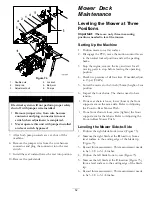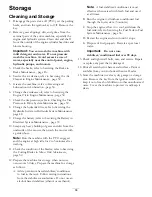
12. Start the engine and let it run for about two minutes
to purge air from the system. Stop the engine and
check for leaks. If one or both wheels will not drive,
refer to Bleeding Hydraulic System.
13. Recheck the fluid level while the fluid is warm. The
fluid should be between cold and hot.
14. If required, add fluid to the hydraulic tank. Do not
overfill.
Figure 72
1.
Hydraulic filter
3.
Adapter
2.
Gasket
Bleeding the Hydraulic System
The traction system is self bleeding, however, it may be
necessary to bleed the system if fluid is changed or after
work is performed on the system.
1. Raise rear of the machine so wheels are off the
ground and support with jack stands.
2. Start the engine and run at low idle speed. Engage
the lever and traction on one side and spin the wheel
by hand.
3. When the wheel begins to spin on its own, keep it
engaged until wheel drives smoothly. (minimum
2 minutes)
4. Check hydraulic fluid level and add as required to
maintain proper level.
5. Repeat this procedure on the opposite wheel.
Checking the Hydraulic Hoses
Service Interval:
Every 100 hours
Check the hydraulic hoses for leaks, loose fittings,
kinked lines, loose mounting supports, wear, weather
and chemical deterioration. Make necessary repairs
before operating.
Note:
Keep areas around the hydraulic system clean
from grass and debris build up.
Hydraulic fluid escaping under pressure can
penetrate skin and cause injury.
•
If hydraulic fluid is injected into the skin
it must be surgically removed within a few
hours by a doctor familiar with this type of
injury. Gangrene may result if this is not
done.
•
Keep body and hands away from pin hole
leaks or nozzles that eject high pressure
hydraulic fluid.
•
Use cardboard or paper to find hydraulic
leaks.
•
Safely relieve all pressure in the hydraulic
system before performing any work on the
hydraulic system.
•
Make sure all hydraulic fluid hoses and
lines are in good condition and all hydraulic
connections and fittings are tight before
applying pressure to hydraulic system.
Setting the Hydraulic Pump
Neutral Position
Note:
Adjust the handle neutral first. That needs to be
correct before the following adjustment can be made.
This adjustment must be made with drive wheels turning.
Mechanical or hydraulic jacks may fail to
support machine and cause a serious injury.
•
Use jack stand when supporting machine.
•
Do not use hydraulic jacks.
Engine must be running so motion control
adjustment can be performed. Contact with
moving parts or hot surfaces may cause
personal injury.
Keep hands, feet, face, clothing and other body
parts away from rotating parts, muffler and
other hot surfaces.
50





























